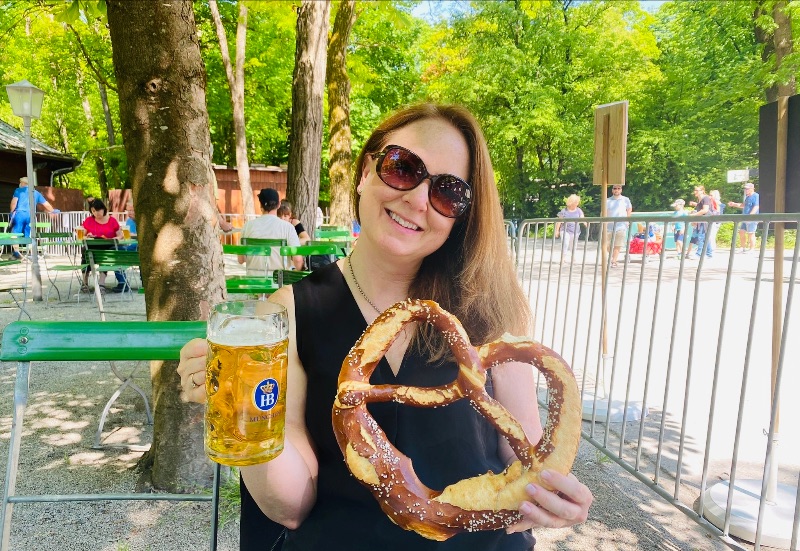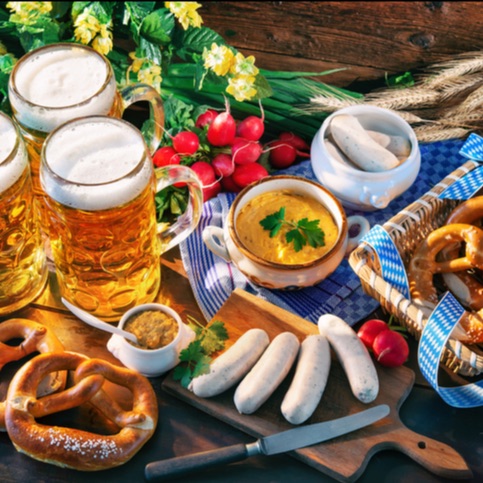It has been another incredible week in Bavaria with the highlight being a tour of Munich’s city center. I joined my favorite guide, Jax of Heart of Munich Tours, who offers incredibly informative and interesting tours. Not only does he show you the main sites, but also points out items of interest you would miss on your own. He is the perfect type of guide I use for my clients – knowledgeable and fun. You can find photos of the tour on my Facebook and Instagram.
In addition to my love of Bavarian pretzels, beer from this region is also a favorite of mine. Bavarians are particularly proud of their beer and rightly so. It is greatly ingrained in their culture and I have found that drinking water is merely tolerated. My very Bavarian partner likes to remind me of a saying they have here when I deign to order a water (to be fair I have also ordered a beer) “da poppen die Fische darin”. I won’t translate, but you may get the gist. We always have a good laugh and I am, of course jesting a bit, but I now drink my water at home.

Beer (Bier) is a staple of Germany.
In fact the oldest brewery in the world (or at least it claims to be) is Weihenstephan located at the Weihenstephan Abbey in Freising, Bavaria. The first historical mention of hops connected to the Abbey was in 768 and the monks who lived here produced and sold their beer until it was dissolved in 1803 and transferred to the state of Bavaria. There are now over 650 breweries in Bavaria which make up 50% of the total amount in all of Germany.
In Munich they have what is the called “Big 6”. These are the only breweries that are allowed to serve their brews at the world-famous Oktoberfest: Augustiner, Hacker-Pschorr, Hofbräuhaus, Löwenbräu, Paulaner, and Spaten-Franziskaner
Each beer must follow the Reinheitsgebot (purity order) and the current one was decreed in 1516. In a nutshell this means that the beer must be brewed in Munich, have a minimum of 6% alcohol and must only be made with water, barley, hops, and yeast. In 1993 the law was updated to allow other ingredients to be added as long as it is not called beer.
Know Your Bavarian Beer
HELLES: A pale lager, easy to drink
PILSNER OR PILS: Golden-color with a more bitter taste than Helles
DUNKEL: Dark beer made using Munich Malt giving it a slightly darker taste, with subtle flavors of caramel, toffee and nuts
WEIßBIER / HEFEWEIZEN: White beer / Yeast wheat beer. Made with more then 50%+ of malted wheat
BOCK and DOPPEFLBOCK BOCK: A dark and malty beer. Doppel (meaning double) tastes even more so
RADLER: A minimum of 50% beer mixed with citrus, such as lemon soda
Weißwurst Frühstück

The Weißwurst (white sausage) was created in 1857 and are made with a thinner casing thus making them more perishable. And since back in the day they did not have proper refrigeration they had to be eaten before noon. This tradition still carries on today – it is quite the faux pas to order them any other time of the day.
Your breakfast will include two sausages served in a tureen of warm cooking water, a pretzel, and sweet mustard (FYI…the mustard is for the sausage, not the pretzel.) And, of course, a local weißbeir.
Local Tip: Do not eat the casing! Snip the end off, make a slit along the top of the sausage, then peel if off using your knife and fork.
Join me as I share with you the everyday adventures of this Colorado girl now living in Tuscany. I hope to inspire you to discover new destinations, will offer invaluable travel tips and updated travel news.
welcome to my
home on the web
Discover travel
travel tips
culture travel
Discover Hidden Gems of Italy
FREE RESOURCE
The great cities of Rome, Florence and Venice offer treasures untold, but there is so much more to be discovered in this beautiful country. Let this guide inspire you to travel off the beaten path to discover the soul of Italy.